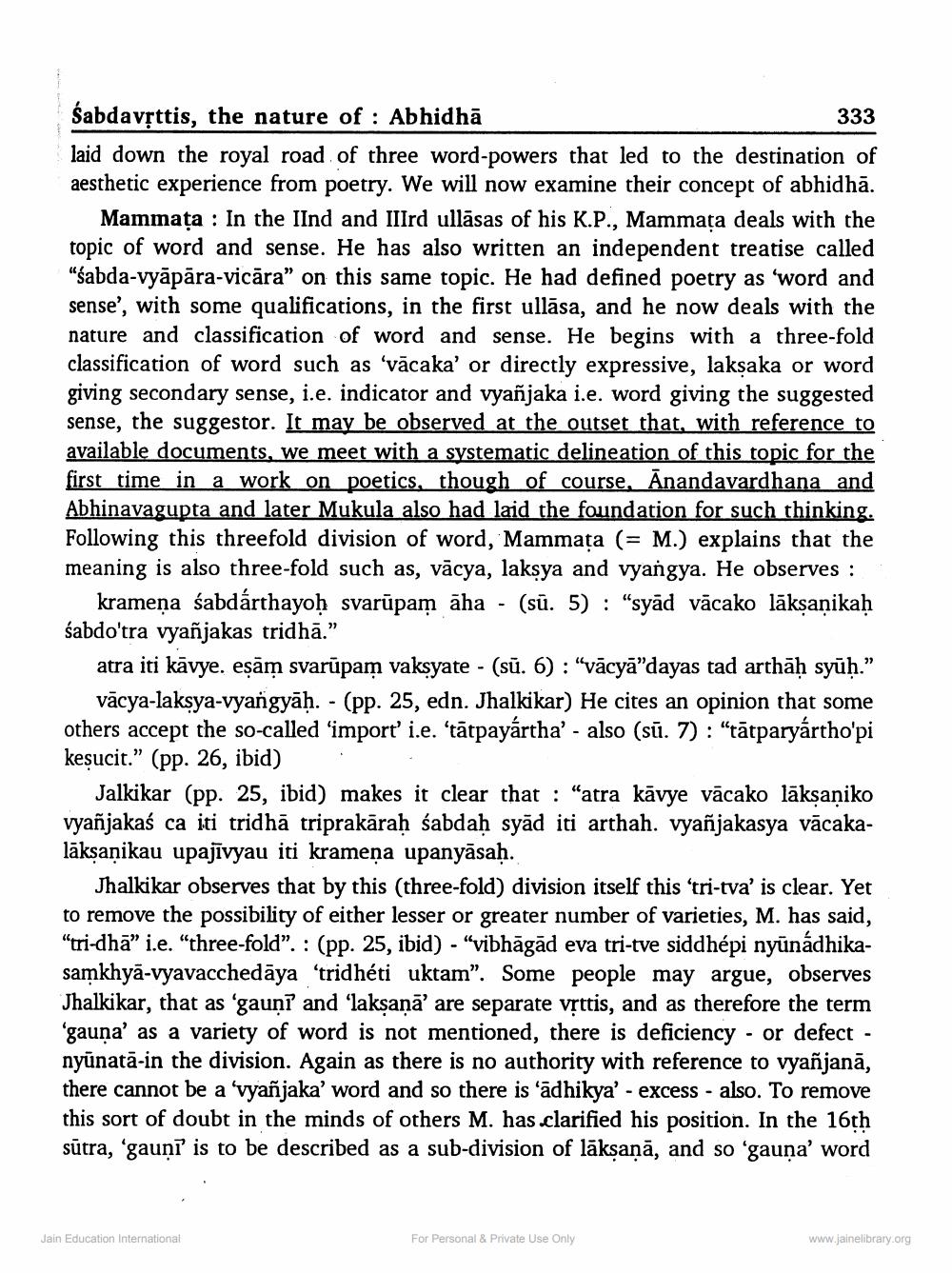________________
Śabdavșttis, the nature of : Abhidhā
333 laid down the royal road of three word-powers that led to the destination of aesthetic experience from poetry. We will now examine their concept of abhidhā.
Mammata : In the lind and IIIrd ullāsas of his K.P., Mammata deals with the topic of word and sense. He has also written an independent treatise called "sabda-vyāpāra-vicāra" on this same topic. He had defined poetry as 'word and sense', with some qualifications, in the first ullāsa, and he now deals with the nature and classification of word and sense. He begins with a three-fold classification of word such as 'vācaka' or directly expressive, laksaka or word giving secondary sense, i.e. indicator and vyañjaka i.e. word giving the suggested sense, the suggestor. It may be observed at the outset that, with reference to available documents, we meet with a systematic delineation of this topic for the first time in a work on poetics, though of course, Anandavardhana and Abhinavagupta and later Mukula also had laid the foundation for such thinking. Following this threefold division of word, Mammata (= M.) explains that the meaning is also three-fold such as, vācya, laksya and vyangya. He observes :
kramena sabdarthayoh svarūpam āha - (sū. 5): "syād vācako lūksanikah śabdo'tra vyañjakas tridhā.”
atra iti kāvye. eşām svarūpam vaksyate - (sū. 6) : "vācyā”dayas tad arthāḥ syūḥ.”
vācya-laksya-vyañgyāḥ. - (pp. 25, edn. Jhalkikar) He cites an opinion that some others accept the so-called 'import' i.e. 'tātpayārtha' - also (sū. 7) : “tātparyārtho'pi kesucit.” (pp. 26, ibid) :
Jalkikar (pp. 25, ibid) makes it clear that : "atra kāvye vācako laksaniko vyañjakaś ca iti tridhā triprakāraḥ śabdaḥ syād iti arthah. vyañjakasya vācakalākṣaṇikau upajīvyau iti krameņa upanyāsaḥ.
Jhalkikar observes that by this (three-fold) division itself this 'tri-tva' is clear. Yet to remove the possibility of either lesser or greater number of varieties, M. has said, "tri-dhā” i.e. "three-fold”. : (pp. 25, ibid) - “vibhāgād eva tri-tve siddhépi nyūnádhikasamkhyā-vyavacchedāya 'tridhéti uktam”. Some people may argue, observes Jhalkikar, that as 'gauni and 'laksaņā' are separate vsttis, and as therefore the term 'gauna' as a variety of word is not mentioned, there is deficiency - or defect - nyunatā-in the division. Again as there is no authority with reference to vyañjanā, there cannot be a 'vyañjaka' word and so there is ‘ādhikya' - excess - also. To remove this sort of doubt in the minds of others M. has.clarified his position. In the 16th sūtra, 'gauni' is to be described as a sub-division of lāksanā, and so 'gauna' word
Jain Education International
For Personal & Private Use Only
www.jainelibrary.org




